Heading into tomorrow’s Crossroads Classic match-up against Purdue, one of the prevailing pre-game questions has been one that is fairly familiar to Irish squads of the past couple of years: how can they handle a team with incredible length? It is no secret that Notre Dame’s calling card for the past few years has been their devastating offensive efficiency; they have often sacrificed size in an attempt to have their offensive machine whirring at full capacity. This often leaves a fairly obvious disadvantage– being exploited on the boards. This narrative is as applicable as ever heading into a Purdue team whose leading contributors are Caleb Swanigan, who averages 15.9 PPG and 11.2 RPG, and junior Isaac Haas, who stands at 7’2″.
I decided to look back at the past two Irish squads to see if they truly did struggle against teams with incredible height. Firstly, I only examined Irish opponents that were in the KenPom top 100 in each season. The Irish have gone 32-0 against teams that are ranked over 100 in the since the beginning of the 2014-15 season, so those results don’t tell us much.
Secondly, the tool I used to examine other teams’ “length” was KenPom’s stat called Effective Height. This measurement looks at the average height of the opposing team’s power forward and center, and is weighted by minutes played. This is much more accurate than merely looking at average height, as when we think of “long” teams, we are mostly talking about their bigs. The fact that Notre Dame has played relatively tall wings like Steve Vasturia and VJ Beachem doesn’t make opposing teams think we are extremely big. You can read more about the utility of Effective Height here.
2015-16
The 2015-16 Notre Dame team actually had a decent amount of effective height, with 6’10” Zach Auguste playing 71% of the available minutes, and 6’8″ VJ Beachem also getting a ton of playing time. I should note that Bonzie Colson played a lot as a second big next to Auguste, although his 6’5″ height does not help the team’s Eff Hgt measurement.
With that in mind, I separated last season’s schedule into 4 groups: those that were higher ranked and taller, higher ranked and smaller, lower ranked and taller, and lower ranked and smaller.
First, let’s look at the group that Purdue falls into this year: teams that were both higher ranked than Notre Dame, and had more effective height.
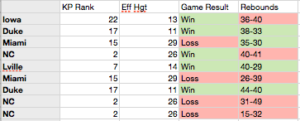
(For reference, Notre Dame had a KenPom rank 37 and Eff Hgt 59)
Notre Dame performed pretty darn well against teams that were both better and taller than them, finishing with a 5-4 record against this group of teams. In fact, all 4 of their losses to this group were at the hands of the same 2 teams– Miami and North Carolina. In 3 of those 4 defeats, the Irish were slaughtered on the boards, with rebounding deficits of at least 13. However, when Notre Dame was able to keep the rebounding numbers close against these taller teams, they had a great amount of success, notably out-rebounding Duke in each victory over the Blue Devils.
Now, let’s look at the numbers against teams that were better than Notre Dame, but had less effective height.

Interestingly, Notre Dame had far less success against smaller teams that were higher ranked than them, going 0-4 agains this section. Of these teams, Indiana, Virginia, and Pitt each had rebounding numbers that were far better than the Irish’s throughout the season, and they exploited that advantage to win both the rebounding battle and the overall battle against Notre Dame. Syracuse did not have great rebounding numbers (perhaps as a product of their zone defense), but they managed to stymie the Irish regardless.
Overall, the 2015-16 Irish actually had more success pulling off upsets over taller teams rather than shorter ones who could match the Irish’s small ball lineups and outwork them on the boards.
The next group (worse/bigger) was comprised of only two teams.

There’s not much we can glean from a two game sample size, but the Irish took care of a Clemson team of comparable Effective Height, and fell to a much taller Florida State team despite not getting killed on the boards.
Finally, we have the worse/smaller bracket.
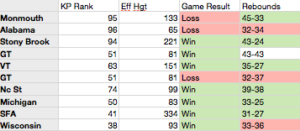
Unsurprisingly, the Irish had their best record against teams that were both worse and smaller than them. The blemishes of this portion of the schedule came against early-season opponents Monmouth and Alabama, who both knocked off an Irish team that was still finding its footing, and a Georgia Tech team that was one of the better rebounding teams in the nation.
So what is the takeaway from last year’s Irish team? Well, when they played massive teams that were also incredibly talented, they actually held their own. While losses against the elite North Carolina Tar Heels ended their postseason runs, the majority of their regular season defeats actually came against teams that had less length than the Irish did.
2014-15
Two years ago, the composition of the Irish lineups was quite different. The Irish played almost exclusively with a 4-around-1 look, with 6’5″ Pat Connaughton as the stretch 4 helping out on the boards. They even played a decent amount of time with 6’5″ Bonzie Colson as the only big on the floor. These factors made the Irish a whopping 215th nationally in Effective Height.
This extremely low rank would make an analysis like I performed on the 2015-16 team essentially pointless, as almost every one of the top-100 opponents the Irish faced was taller than them. The only exceptions to this were Michigan State, who the Irish narrowly defeated in the B1G/ACC challenge, and Wichita State, who the Irish handled in the Sweet 16.
That being said, we can still look at how Notre Dame performed against teams with impressive length. The foremost obvious opponent in this category was Kentucky, which ranked #1 in both overall KP rank and Effective Height. Despite this enormous height disparity, Notre Dame only lost the rebounding battle by 1 to the Wildcats, and came quite close to pulling off an upset for the ages.
That Irish team faced three other teams in the top 20 in Effective Height. They easily handled the second-biggest team in the nation, Florida State. Early on, they dropped a heartbreaker to the 6th biggest team, Providence, despite winning the rebounding battle in that game. Finally, they took care of Purdue at the Crossroads Classic, out-rebounding the 19th ranked team by 8.
One could say that that 2014-15 team had a special knack for stepping up in big games, and while they dropped some tough decisions to Kentucky and Providence, they proved that they were so lethal offensively that they could weather the storm on the boards and still emerge victorious. Out of the 23 top-100 opponents that Irish team faced, they only won the rebounding battle in 6 of those games. Despite being at a rebounding disadvantage in almost every game, they went 17-6 in those encounters.
2016-17
Finally, we arrive at this year’s team. In terms of effective height, this team is much more like the 2014-15 team than last year’s iteration of the Irish. Notre Dame ranks 171st in the nation in effective height, and we can expect to be at a height disadvantage throughout the majority of the ACC schedule.
Thus far, however, Notre Dame has already faced two top-100 teams that are actually smaller than them, Northwestern and Villanova. Despite matching up with these teams better size-wise, the Irish dropped a close one to Villanova and barely escaped against Northwestern. The two teams the Irish have faced that have been taller than the Irish, Colorado and Iowa, have both been mostly straightforward victories.
So after looking at the results of the past 2+ seasons, we can look back to the question I posed– are the Irish at a severe disadvantage against teams with great length? I would lean towards saying no. Notre Dame has shown the ability to fight against much taller teams time and time again, managing to outscore their opponents in the column that matters despite often losing the rebounding battle. While the Irish have dropped games to elite, gigantic teams (think last year’s North Carolina), they have won their fair share of those match-ups against the Louisvilles and Dukes of the world.
Purdue will pose an intriguing challenge for the Irish tomorrow because they are a very good team, but the Irish have proven that they will not be intimidated by their length alone. Purdue could very well win the rebounding battle against the Irish tomorrow, but if the Irish can keep that margin within single digits, their offensive prowess could allow them to pull off the upset.

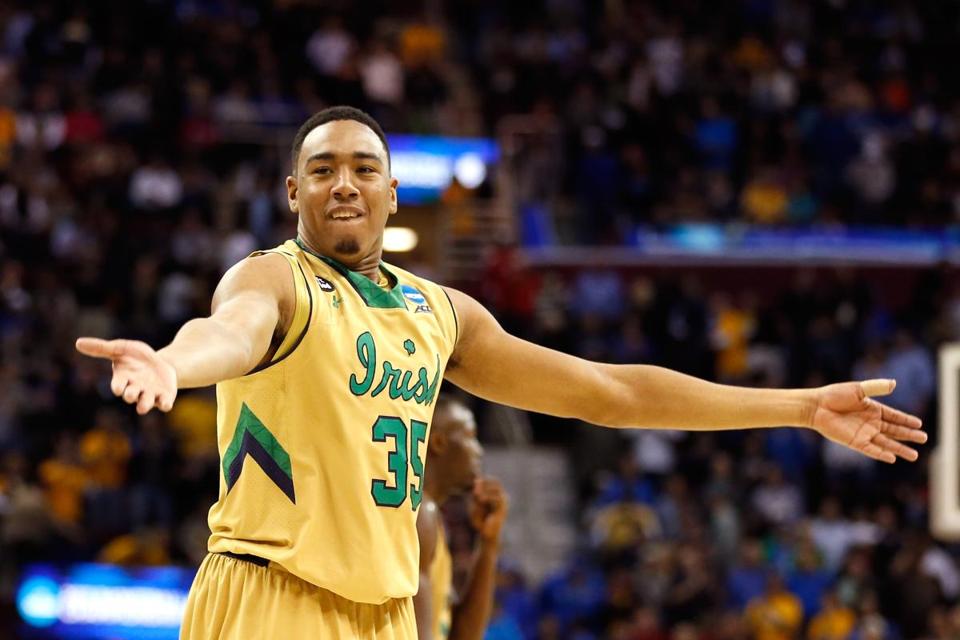

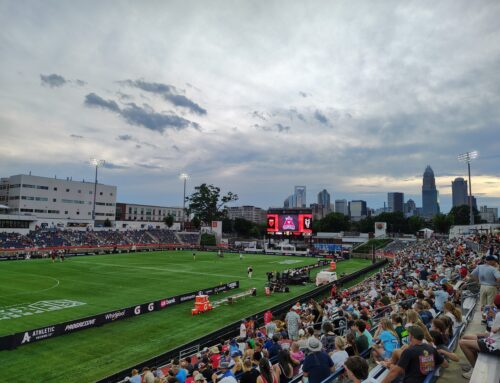
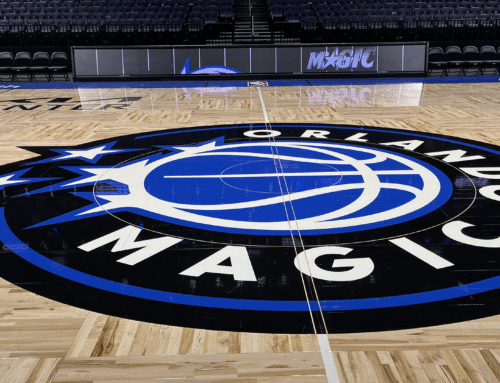
I’ve been wondering this exact thing for a long time, but I wouldn’t have had any way of doing the analysis. Thanks for this, it’s fantastic. It does always seem like we go into these match ups against the big teams and hear about how difficult it’s going to be for ND to keep up because we won’t be able to compete on the boards. And yet it’s always felt like we’ve done pretty well keeping up with the big boys. This confirms that feeling for me.
However, I definitely didn’t see the flip side coming. It makes sense that we struggle against the smaller, more athletic teams (the inability to defend the 3 point line despite constantly practicing against great 3 point shooting baffles me), but I certainly didn’t expect it to be such a clear line in the sand. Again, thanks for this, keep up the good work. It’s why you guys are the best ND basketball site out there.
This is awesome. Thanks for digging in to it.
For me, the officials could help us out early in this one by rewarding good rebounding position. If our guys are getting shoved under the basket from behind or having their backs crawled over, we need that call early and often. The Irish have to be a position rebounding team, but when B10 style refs buy in to the pro-Purdue and pro B10 bruiser-ball style of play, we could be in a bit of trouble. That’s clearly going to be a thing to watch early.
The good news for Brey is that he can play a game like this 2 different ways. He can try to bang with Geben and Bonz up front. He gives up a lot on the offensive end in this set-up, but it does give Bonzie a smaller defender and presumes Geben can help end defensive possessions with a rebound. If that’s not working, you just go small with VJ or Ryan at the 4 and hope for the best. In that scenario, we need to be scoring over 1.25ppp and hope that Rex, Steve, and VJ commit the the defensive glass enough to limit the bleeding. It is always good to have options, even if neither is perfect.
This will be an interesting game to test out the #FreeElijah narrative. If we need some bulk and rebounding, can Burns be the guy or will it be Torres? Obviously, the fear when you have Torres out there is that you’re clogging up the offense and giving Purdue a guy they don’t need to defend beyond 6 feet from the rim. Perhaps Burns is at least a little more threatening?